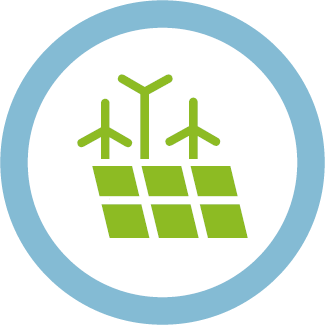Industry and Commerce Research Network

In the Industry and Commerce research network, experts exchange information relating to energy efficiency in industry and commerce. They provide impetus to the Federal Ministry for Economic Affairs and Energy for future funding strategies, collate key issues, and use their wide range of expertise to deliver innovative concepts and ideas that will help the energy transition succeed.
The members of the network develop research roadmaps in addition to position and strategy papers, and by doing so make the advancements and innovations in the fields of industry, commerce, trade, and services more transparent. Under the umbrella of the energy research network, its stakeholders are active in the research fields of waste heat, chemical process engineering, iron and steel, production engineering, high-temperature superconductivity, and tribology. The structure of the research fields allows the research into these selected key issues to have a powerful impact. At the same time, the research fields remain flexible in order to take individual innovative issues into consideration. The increasing importance of cross-discipline cooperation is essential in attaining excellent and practically oriented research results, and in improving Germany’s position within an internationally competitive environment.
Energy research funding in industry and commerce
The focus of research in the field of industry and commerce is on innovative, efficient, and flexible processes and technologies that reduce energy consumption. In many areas, the options for optimizing the energy consumption of individual machines and processes have now been almost exhausted. Therefore, entire process chains for production methods and the energetic interaction from the raw material to the finished product are a focus of research and development. This also includes the energy-efficient use of secondary forms of energy in industrial processes. Because of the large number of industries and processes, virtually no overarching concepts exist to date in the area of industrial process heat, for example. In a first step, researchers are working on individual ways to decrease the thermal energy needed in a particular process while maintaining the same product quality. In the following step, these results will be transferred to a wide range of applications in the various industries.
Artificial intelligence, sensor systems, and circular CO2 economy
In order to stay competitive internationally, digitization in production needs to gain in momentum and scope in the field of industry and commerce in future. The topics of artificial intelligence, sensor systems, and the circular CO2 economy are therefore effectively linked in the network’s individual research fields. This enables long-term research cooperation agreements and creates synergies. The stakeholders in the Industry and Commerce research network apply their expertise to help shape research funding and deliver a major building block for the energy transition.
Heat is generated in almost every industrial process. This ranges from comparatively low temperatures of around 40 degrees Celsius, generated in industry by technical equipment such as compressors or pumps, to over 1.000 degrees Celsius in combustion processes. Waste heat can be used directly as heat for downstream processes at lower temperature levels. Indirect use is possible if the heat is converted into electricity using thermoelectrics or the organic Rankine cycle, for example, or upgraded using efficient heat pumps and fed back into high-temperature processes. In all applications, interactions and relationships between heat sources, heat sinks and thermal storage systems, as well as the feedback effects or grid services on the energy system must be considered.
Contact
Dr. André Schlott
E-Mail: andre.schlott@ifam-dd.fraunhofer.de
Website: Fraunhofer Institute for Manufacturing Technology and Applied Materials Research IFAM
Steffen Linsmayer
E-Mail: s.linsmayer@ptj.de
Website: Project Management Jülich
Chemical process engineering deals with processes in which substances are modified in terms of their type, properties, and composition. The stakeholders in the research field on chemical process engineering exchange expertise on topics such as new reactor concepts that make continuous and energy-efficient operation of the processes in the relevant systems possible. In practice, a wide range of processes are executed one after another in batches. These batch processes lead to discontinuous production and make energy recovery and precise kinetic control difficult. The researchers develop modular systems that make production processes more flexible and integrate new processes faster. To ensure that modular systems are economically successful, a uniform data structure is essential. This allows the modules to communicate and their entire life cycle to be documented. However, the benefits in terms of efficiency yielded by digitizing industrial processes can only be exploited if the sensor elements also provide correct and valid data.
Contact
Dr. Kathrin Rübberdt
E-Mail: kathrin.ruebberdt@dechema.de
Website: DECHEMA - German Society for Chemical Engineering and Biotechnology
Dr. Michael Gahr
E-Mail: m.gahr@ptj.de
Website: Project Management Jülich
Many processes that take place at temperatures above 1,000 degrees Celsius are currently operated with burners based on fossil fuels. The high temperatures are necessary in the production of glass, ceramics, bricks and metals, as well as in cement and other industries. To reduce energy consumption, process temperatures and thus fuel requirements should be lowered - this can be achieved, for example, by more precise process control at the limits of the technically necessary temperature windows.
The aim is also to defossilize processes and completely replace fuels such as natural gas and coal. If this is technically possible, in the future, some processes can be heated electrically with climate-neutral electricity. Another alternative is to switch to climate-neutral fuels. For economic reasons, this can be designed gradually and serve as a transition technology. In all cases, there is a need for research and development: in the adaptation of heat generation, heat input and process control.
The new research field of thermoprocess technology emerged from the broadening scope of topics of the former research field of metal production and processing.
Contact
Dr. Ralph Edenhofer
E-Mail: r.edenhofer@ptj.de
Website: Projektträger Jülich
The stakeholders involved in the research field on production engineering look at the energy-related correlations in process chains, so that a real impact can still be achieved even if the options for optimizing individual processes have been exhausted. The scientists develop solutions for establishing networks not just between individual machines, but also between the machines, building technology, and building envelope, so that energy can be used and stored as efficiently as possible. To improve energy efficiency in production, research and development is also focused on integrating more key technologies in the future, for example nanotechnology, plastics engineering, or bioprocess engineering. Additive manufacturing – better known as 3D printing – is set to transform the industrial value chain and is one of the challenges facing production engineering. In contrast with subtractive and formative processes, additive manufacturing processes allow complex geometries and internal structures to be produced layer by layer.
Contact
Prof. Matthias Weigold
E-Mail: m.weigold@ptw.tu-darmstadt.de
Website: Technische Universität Darmstadt - Institute for Production Management, Technology and Machine Tools
Dr. Stefan Busse-Gerstengarbe
E-Mail: s.busse-gerstengarbe@ptj.de
Website:Project Management Jülich
A high-temperature superconductor (HTSC) can relay electrical current with almost no loss and has 10 to 100 times the current-carrying capacity of a copper wire with comparable dimensions. HTSCs have a variety of possible uses ranging from energy technologies to specialized industrial applications and modern power grids, and help to increase the efficiency of the overall energy system. High currents of up to several hundred kiloamperes are applied in electrolysis systems in the base material industry – for example when producing chlorine, copper, or aluminium. If these currents are carried by compact, superconductive high-current rails in future, the significant energy losses caused by electrical resistance would be eliminated. Rotating machines, such as engines and generators, can be designed so as to be more powerful and energy efficient while maintaining the same dimensions. For electrical generators – even those with a very high efficiency at the upper end of the performance spectrum – HTSC technology makes it possible to increase their efficiency by a few more tenths of a percentage point.
Contact
Prof. Tabea Arndt
E-Mail: tabea.arndt@kit.de
Website: KIT- Karlsruher Institut für Technologie - Institute of Technical Physics (ITEP)
Ralf Egen
E-Mail: r.egen@ptj.de
Website:Project Management Jülich
In-depth knowledge from the worlds of physics, chemistry, and various fields of engineering are needed to firstly understand and then to comprehensively optimize the range of phenomena related to friction, wear, and lubrication. Networking with other research priorities is therefore essential. Lubricant has the biggest effect on a tribological contact between friction partners, since it can be used to limit certain factors. In research and development, for example, new materials – including coating materials – are developed and systematically examined for their suitability using tribometers. Tribological research shows, for example, that a machine with different friction pairings must be viewed as a system and requires a global approach. Within this context, topics that are gaining in importance for researchers include digitization, artificial intelligence, new technologies for recording data, and the use of the latest data analysis methods to understand tribological data.
Contact
Dr. Volker Weihnacht
E-Mail: volker.weihnacht@iws.fraunhofer.de
Website Tribology Innovation Center Dresden (TICD) am Fraunhofer-Institute for Material and Beam Technology IWS
Dr. Stefan Busse-Gerstengarbe
E-Mail: s.busse-gerstengarbe@ptj.de
Website: Project Management Jülich
Heat pumps are a key technology for climate-neutral heating of buildings. They collect environmental heat, raise this energy to a higher temperature level using small amounts of future green electricity, and transport it into the building interior. In the course of the heat transition, it can be expected that heat pumps will be used in large numbers and in basically similar installation situations. There is therefore a strong incentive to further optimize the technology of components, equipment and systems and their production - as this can reduce energy consumption and increase cost-effectiveness.
Industrial heat pumps for higher temperatures, on the other hand, are not yet widespread. One obstacle to their economic application is that the efficiency of the heat pump depends crucially on it being optimally adapted to the available heat sources and heat sinks. To this end, it must be individually integrated into the existing process technology. In addition to developing components and equipment, research is therefore also needed to simplify integration.
Contact
Dr.-Ing. Marek Miara
E-Mail: marek.miara@ise.fraunhofer.de
Website Fraunhofer Institute for Solar Energy Systems ISE
Steffen Linsmayer
E-Mail: s.linsmayer@ptj.de
Website: Project Management Jülich

Accompanying research on industry and commerce
An accompanying research team works in close collaboration with the fields of research pursued in the Industry and Commerce research network. Together with the network’s members, the team identifies solutions in research and development that have the potential to increase energy efficiency in industry and commerce.
To do this, the scientists analyse individual funding projects as well as ongoing projects assigned to the network’s research fields, so that crucial innovations can be recognized, integrated into the network, and put to use in as many applications as possible in the long term. Research results achieved within the Energy Research Programme or on the international scene are fed into the team’s industry- and technology-neutral analyses.
The accompanying research team highlights which efficiency solutions are already successfully in place in a particular branch of the industry and could be transferred to other areas. The team of researchers develops recommendations for action for future research activities in close cooperation with stakeholders from the network’s research fields.
TU Darmstadt is responsible for project coordination for the accompanying research team. Other partners include Karlsruhe Institute of Technology (KIT), the Institute for Resource Efficiency and Energy Strategies (IREES), and ETA-Solutions, a service provider and spin-off company of TU Darmstadt. The project launched in October 2018 and ended in 2021. During that time the team published a number of research papers.
- Energy Research Networks
- Bioenergy Research Network
- Energy Transition Construction Research Network
- Energy Transition and Society Research Network
- Renewable Energy Research Network
- Industry and Commerce Research Network
- Power Grids Research Network
- System Analysis Research Network
- Hydrogen Research Network









